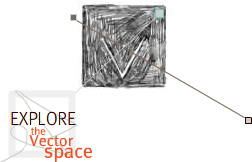Slavery's Ephemera
The Contemporary Life of the Antebellum Plantation
Design by Erik Loyer
Author's Statement
"Y'all not from 'round here, are ya?"
Throughout numerous visits to the remnants of New World slavery in Plantation Country in the Lower Mississippi Valley of southern Louisiana, this refrain was repeated so often by all I met—whether black, white, creole, affluent or destitute—as to make me wonder about my solidity. Was I some tourist who flitted through these overwrought landscapes like a ghost? Could my presence—as a black woman, without local accent—be tolerated at the remains of plantation complexes and plantation sites only if I was discursively placed as not being "from 'round here"?
So, as much as I could, I played the part of tourist for the research for this project on the contemporary life of the antebellum plantation in the U.S. imagination. But, as I did the research and after, the role of tourist within these spaces always seemed like an ill-fitting garment—I dressed in what parts I could and made do: in rural Louisiana, I was usually the only black person on a tour with whites from the U.S. and Europe; I was usually the only black person who paid an entrance fee and was not an employee of the plantation museum/foundation; I was usually the only academic doing research and "played" tourist to learn what was said on the "regular" tour.
What is the nature of the ephemeral within tourist spaces, but also within institutional and cultural phenomena which purportedly no longer exist, like chattel slavery in the New World? As I surveyed my substantial haul of tourist ephemera—pamphlets, brochures, paper fans with family histories on their flipsides, Mammy doll plantation magnets—and the extensive photographic record that I compiled during three different research trips, I yearned for innovative ways to tell the story of slavery's ephemera, of its afterlife, of an 'undead' seemingly alive and well in south Louisiana.
Having given conventional academic presentations of this research, complete with dozens of slides, on several occasions, I found audiences eager for the talk, but either still enraptured by the glories of a plantation ideal already hard-wired in their U.S. perceptions of the 'good life' or completely ignorant of any reference to white columns, including Gone With the Wind. I knew that I had assembled an archive that would allow me to recount a different yet compelling narrative of the institution of slavery from the vantage of an iconic actor—the remains of plantation complexes, though, in this case, not precisely sentient.
Enter stage right, Erik Loyer, Project Designer and Vector's Co-Creative Director. When I returned from the decimation of New Orleans post-Hurricane Katrina in November 2005, Erik listened as I recounted what it was like to inhabit what was in essence a very large and very filthy bathtub of a city whose ring of dirt could be tracked zone by zone as the levee waters receded.
So Erik and I were able to imagine a river (whether Faulkner's, Twain's, or Robert Johnson's) whose resources flow to the metropolitan basin of New Orleans, as they have done for more than three hundred years. No less than the iconic urban image of the flooded shotgun house inside the city's boundaries, the remnant of the plantation complex 'upcountry,' exists as one link in a chain of "property" holdings whose relationship to the enterprise, institution and culture of slavery remain. This project centers upon a composite Louisiana cartography, enhancing the past and present dominance of the Mississippi River and grafting plantation sites from its other tributaries (namely Cane and Red Rivers) on it. We wanted you to move through space that is controlled by water since much of the Mississippi can still only be traversed by ferry, because of the dearth of span bridges.
This Mississippi River is an heuristic: there is some accuracy in terms of locations on its east or west banks, but I most wanted to re-link Louisiana plantation 'upcountry' to New Orleans metropolitan life. The bottom of that topographic funnel has always been New Orleans. Call the metropolis a kind of sieve, catching all the resources extracted and products made upriver. New Orleans in this sense has always been a city of markets — where nearly any thing or item imaginable could be bought and sold — from eggplant and creole tomatoes, from German china and Asian flora (the first Japanese varieties of camellias were shipped through New Orleans), to cotton bales and slaves. So in addition to being the aperture of a funnel, New Orleans is also the hub in a spokewheel of outlying markets. In this sense of political economy, the continued ephemerality or evanescence of the remnants of plantation life is maintained through the willed fiction that plantation and town were separate and discreet, not the intimate partners in the economic and social life of slavery that they, in reality, were.
Final words of gratitude to Erik for helping me realize visually the elusive nature of power relations within these landscapes. I invite you to consider the effects of new and unexpected juxtapositions between the plantation ideal and tradition, plantation slavery and plantation tourism. It is exactly this combination, what historian Michel-Rolph Trouillot calls the power of juxtaposition in the making and writing of history which occurs at the moment of fact creation, fact assembly, fact retrieval and retrospective significance, that the design of this river and this project help to illuminate.
A final word on what's not here (and should be): a more intense engagement with the cumulative environmental hazards and effects of thriving 19th-century sugar and 20th-century petrochemical industries. This is a topic that demands attention but is well beyond the scope of this current project even as its traces are evoked.



